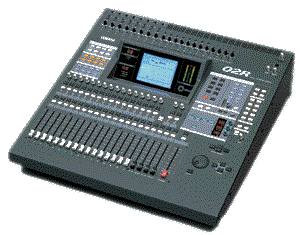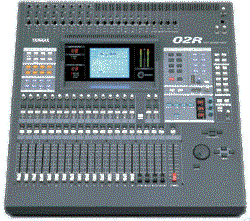|
Digital Recording Console By Mel Lambert Making a successful transition from analog to digital production involves a cornucopia of options, not least of which is the cost involved. Until now, replicating in silicon the types of complex mixing and processing functions normally performed by familiar op amps and transistors has come at a high price. At a cost of just under $9,000 for 40-input/8-bus, all-digital console, with full EQ and on-board automation, dynamics and reverb, the much anticipated 02R is destined to find multiple applications throughout the recording, broadcast and post-production industry. While it does have a couple of admittedly minor flaws- almost all based on inevitable cost-savings- the 02R is one of the most exciting pieces of technology I have come across in many a year.
System Configuration and User Interface In its basic configuration, the 40 inputs comprise 24 analog sources and 16 digital, routing to eight multitrack busses, 16 direct outputs, eight auxiliary (foldback/effects) sends, plus the master LR mix. The 16 direct signals can be just that- post-fader outputs for connecting to a tape machine while a separate stereo mix is being created. In reality, these to designations are often identical (think about it), although it does depend on how the 02R will be set up. With the increasing use of ADATs, DA-88s and other forms of modular multitracks, we are normally listening through the tape machine; sources routed to it appear on channel returns that are mixed onto the master stereo busses. In this way, the distinctions between tracking, overdubbing and mixing become blurred; in reality, we transition from live sources to off-tape replay as our tracks become filled. In the center of the console is a back-lit, 320- by 240-pixel graphic LCD screen that forms the heart of the 02R's control scheme. When a particular channel is selected via a "SEL" button, the screen displays all settings, including EQ profile, dynamic slopes and envelope, I/O assignments, and more. To the right is a Virtual Control panel that contains master controls for the output-bus routing, odd/even panning, four-band EQ, plus aux send assignment and level control. At the top of the console are gain trims for the various analog input sources, plus phantom-voltage switches, pads and phase invert for the first eight channels. The 02R's large display screen provides 12-segment metering for all input channels, as well as for bus outputs and aux send levels. Signals can be metered at several points in the signal path, including pre-EQ, post-EQ or post-fader. A meter peak-hold facility is also provided. The main control room output signal is metered using a dedicated pair of 21-segment bargraph meters, mounted alongside the display screen. An optional meter bridge ($1,299) provides switchable monitoring of inputs signals, buss outputs and the master mix, in addition to various system displays. For a typical session we might use the first 24 channels for live sources- 16 mono sources for studio mics, for example, plus four stereo/two-channel inputs- and the remaining 16 for tape machine returns from a pair of digital multitracks whose outputs are being mixed to the LR stereo output. Multitrack routing will be across eight output busses and/or the 16 direct outputs, dependent upon the required results. The CD8-TD I/O card handles direct connection for eight channels of Tascam TDIF-1 (DA-88) format digital I/Os; the CD8-AT offers the same functions for Alesis ODI (ADAT) ports; the CD8-AE handles eight channels (four pairs) of AES/EBU-format signals; and the CD8-Y accommodates eight channels of Yamaha's proprietary Y2 digital format. Finally, the CD8-AD provides eight additional channels of A-to-D and D-A conversion, for users that want to provide a full 40 channels of analog inputs (maybe a live-sound application, for example, or to accommodate larger-format sessions). By populating one, two or the maximum of four interface slots, the 02R can be set up to handle a maximum of 32 digital sources from DA-88s, ADATs or Y2-compatible devices. The only restriction on maximum I/O configuration stems from the fact that the A-to-D/D-to-A and AES/EBU-format modules are twice as large as the ODI/TDIF/Y2 units. Otherwise, you simply populate the four slots with modules that suite your hardware configuration, and away you go! (At press time, I heard that Yamaha planned to release an AES/EBU interface module that features D-sub connectors, and would occupy a single slot, rather that two; more details later.) In terms of pricing, each module is reasonably inexpensive; the ODI/TDIF/Y2 modules sell for $299; the AES/EBU for $399; and the analog card is $799. Also available for $999 is the CD8-CS Interface Kit that plugs between two I/O slots, and allows multiple 02Rs to be cascaded together to provide additional inputs. It's easy to see that for around $10,000, you can put together an "erector-set" 02R that offers up to 24 simultaneous analog inputs for tracking, 32 simultaneous ADAT/DA-88 digital inputs for mixdown, eight busses, eight aux sends and plenty of stereo and direct outputs. All aux sends can be selected pre/post-fader; sends #7 and #8 directly connect to a pair of internal digital reverb and DSP modules that offer the type of effects you would expect from an outboard such as Yamaha's SPX- Series, or something similar. In addition, sends 1/2, 3/4 and 5/6 can be set up as stereo send if necessary. For monitoring and interfacing with external two-track analog/digital playback machines, the 02R offers two pairs of analog inputs (on TRS and RCA/phono connections), plus three stereo inputs (one AES/EBU- and two consumer S/P DIF-compatible formats). For added flexibility, two of the digital inputs can be routed to channels 17/18 and 19/20.
The Dynamics Section provides five modes: compression, gating, ducking, expansion and combined compression/limiting; adjustable parameters include threshold, ratio, output gain, knee, attack and release times. Channels can also linked, and/or driven from separate key inputs. Dynamic sections are provided for each input channel, as well as the eight bus and stereo outputs. In addition, each channel can be set up with individual delay of up to 60 mS, to compensate for inter-mike separation, or to correct for MIDI processing delays. The console's built-in Effects Section provided on Aux #7 and #8 is extremely comprehensive, with individual control of RT60, HF decay, diffusion, pre-delay, density, low/highpass, reverb delay and reverb balance. All EQ, dynamics and effects settings can be saved in a non-volatile library. A total of 32 EQ, 40 dynamics and 40 effects settings are included within the library as factory presets; the user is provided with another 90-odd programmable areas per function. A total of 64 Scene Memories can be stored as snapshots of all fader and parameter settings. Snapshots can be relocated off-line to a different timecode or MTC value. A "Fader Recall Safe" function lets the user specify which faders are immune to snapshot recall, thus leaving them unaffected for real-time automation. Up to four fader and four mute groups can be set up easily. The 02R ships with 512 KBytes of internal RAM, which should be sufficient to handle even the most complex mix. For more demanding applications- a live event, for example, with multiple, timecode-based changes, or an extended mix- more memory can be added in 1-MByte increments, up to a maximum of 2.5 MB. Also available from Yamaha within the near future will be a Mac-based utility, "02R Project Manager," that includes a comprehensive project manager and editor, librarian, and remote-control utility. The program, written in Opcode's MAX programming language, will enable several mixers to be controlled as a single, multi-channel digital mixing system. MIDI control is also possible; a MIDI Local Off mode, for example, will allow the 02R's servo-controlled faders to be used as remote controllers for external equipment. As a test, I dialed in full 18 dB cut at around 1 kHz on one band, and full boost at the same frequency on another; using the EQ in/out key it was possible to monitor the overall effect. With variety of test materials running through the 02R, I couldn't hear a difference when EQ was in or out, and the two bands exactly canceled on another! (Which also says something for the precision with which you can set up notches and other signal manipulations in the digital frequency domain). The dynamics section is also very easy to setup and adjust; a visual display and corresponding gain-reduction meter lets you see instantly what is happening to the input and output signal of the channel/output being manipulated. The 02R's feature-rich automation is easy to master, although the selection of which tracks are armed and which are in relative update mode takes a bit of getting used to. Also, the moving-faders are not a smooth as those we might be used to on admittedly more expensive systems; the overall sonic results, however, were always acceptable. Certainly, the ability to automate fader moves, grouping, I/O configurations, EQs, pans, aux sends, digital effects and a variety of other console parameters is something we can all get used to very quickly. Pressing Recall brings back an entire mixer configuration in a fraction of a second. Scene Memories can be recalled either manually, via a MIDI Program Change message, or referenced to time code as part of an automated mix. An Undo function enables the most recent Scene Memory store or recall operation to be reversed, thereby allowing the previous data to be recovered. It is obvious that the 02R was designed to provide a simple and intuitive user interface, and one that is both fast and easy to operate. The use of long-throw motorized faders, a Virtual Channel module and a large graphical display screen should provide a relatively painless transition from conventional, "one-control-per-function" designs to the types of assignability, reduced front-panel size and instant reset that the 02R can offer. What's missing? I would like to have seen a set of transport controls that could be set up to output standard 9-pin commands for controlling audio and video decks from the 02R. As it now functions, the console's automation chases timecode from an external source, and maintains frame accuracy. All in all, the 02R Digital Recording Console is a truly remarkable piece of technology. For around $10,000 in a typical project-studio configuration, you an have an all-digital 40-channel/eight-buss mixer with 16 direct outs, eight aux busses, parametric EQ, dynamics and internal reverb/special effects. What more could you ask for?
©2025 Media&Marketing. All Rights Reserved. Last revised: 01.04.25 |

 The 02R's front panel is clear and well laid out. It offers a lower bank of 16 mono channel faders, plus four stereo-channel faders, and a stereo master; all lower channels are provided with long-throw (100 mm/four-inch) servo-controlled, moving faders. Above the mono faders are a row of rotary controls that normally control levels from the 16 tape-machine returns, but which can be used for additional analog or digital sources. At the press of a button, the long-throw linear faders controlling levels in the lower bank can be swapped with the upper row of rotary controls, allowing more conventional control of signal levels connected to those source inputs.
The 02R's front panel is clear and well laid out. It offers a lower bank of 16 mono channel faders, plus four stereo-channel faders, and a stereo master; all lower channels are provided with long-throw (100 mm/four-inch) servo-controlled, moving faders. Above the mono faders are a row of rotary controls that normally control levels from the 16 tape-machine returns, but which can be used for additional analog or digital sources. At the press of a button, the long-throw linear faders controlling levels in the lower bank can be swapped with the upper row of rotary controls, allowing more conventional control of signal levels connected to those source inputs.